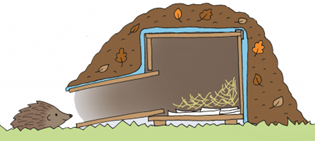Protecting nature and wildlife
It is important to protect local wildlife in your area as their numbers are reducing and they may become endangered and eventually extinct. Below are some tips to encourage wildlife to your local area.
- If you have a garden add some colourful nectar-rich flowers to encourage insects, particularly bees, and other wildlife.
- Add planter boxes or hanging baskets to balconies and windowsills.
- Providing bird boxes, bat boxes and hedgehog homes adds a safe environment to gardens for these animals. Find out how to build a hedgehog home: The Wildlife Trusts - How to build a hedgehog home.

- Leaving bits of grass to grow can provide a habitat to all sorts of wildlife so they can hide and breed.
- Providing a range of plants which flower at different times during the year like berry bushes and fruit trees will provide a source of seasonal food to wildlife.
- Add a pond or water feature which can create habitats for a wide range of wildlife including amphibians, invertebrates and birds.
- Allowing organic material to decompose can create other wildlife habitats in your garden.
- Plant trees which are effective at absorbing carbon dioxide whilst also providing a safe space for birds to build a nest.
Find other useful ideas to help wildlife from the Suffolk Wildlife Trust, including how to make a bee hotel and how to create a container garden for wildlife.
Bee friendly plants
Gardener’s World recommends planting single flowers for bees such as single dahlias so that bees can get to the central part of the flower where the pollen is.
It also recommends purple plants like lavender, alliums, buddleia and catmint as this is the colour bees can see more clearly.
Foxgloves, honeysuckle and snapdragons are tubular-shaped plants that are all important food sources for bees.
Why do we need to protect bees?
Bees pollinate our crops, trees and flowers that are essential for us to eat and for providing habitats for wildlife. However, bee numbers are decreasing globally due to habitat loss, climate change, pesticide use and parasites and diseases.

